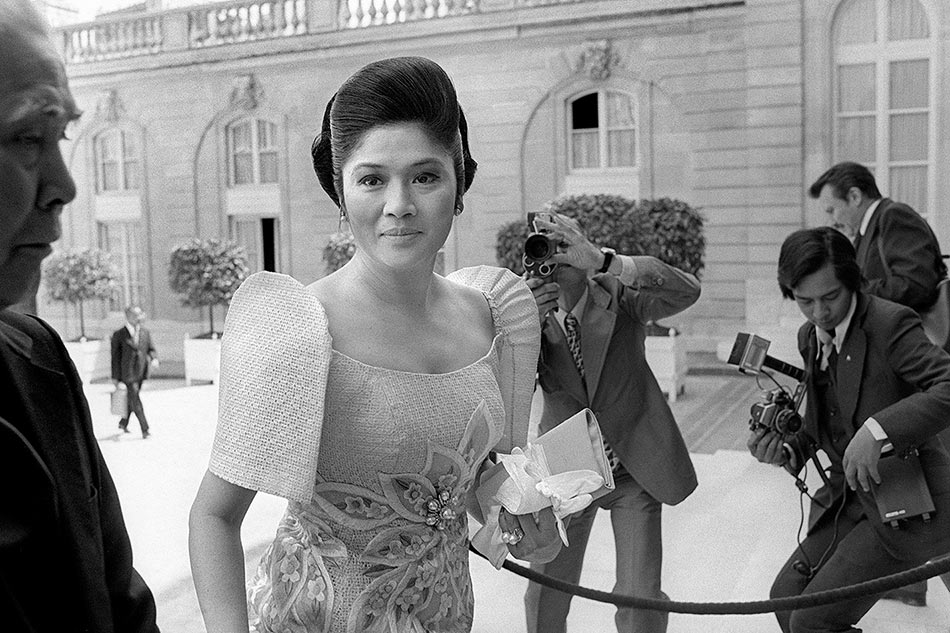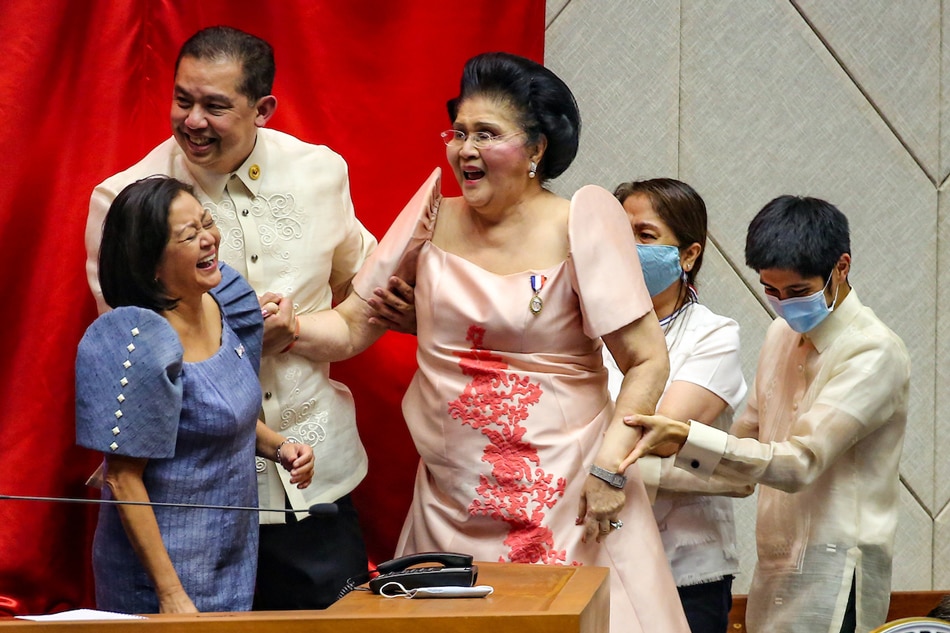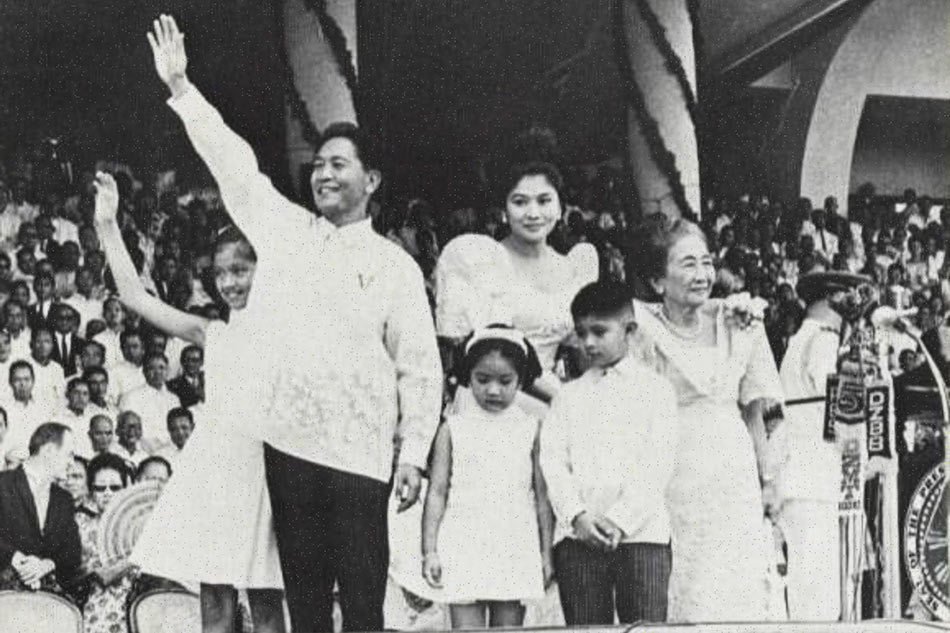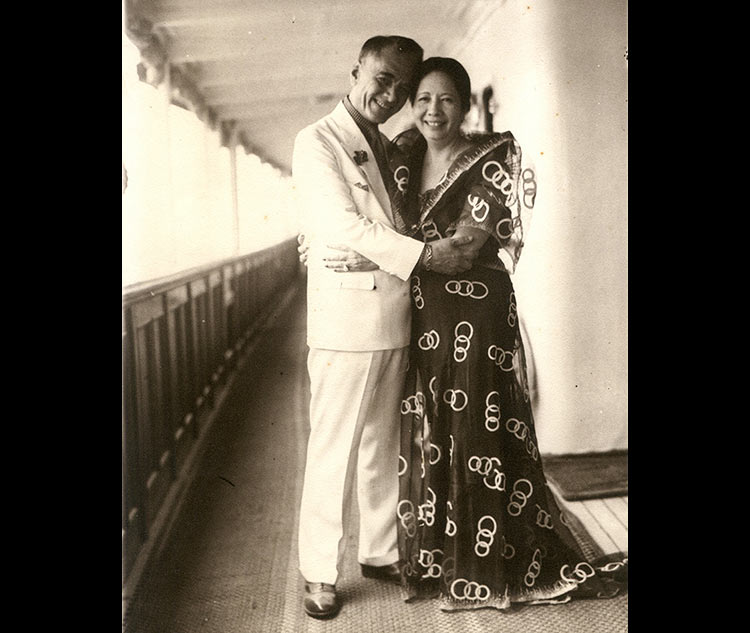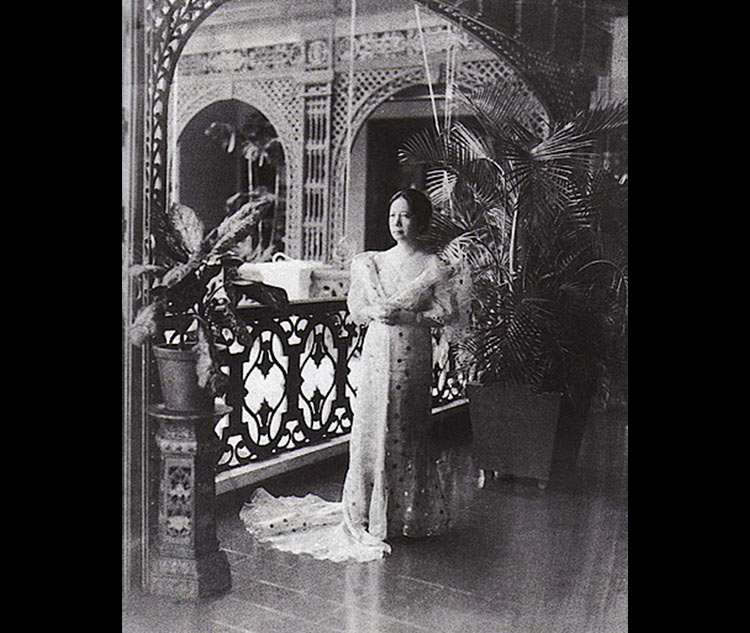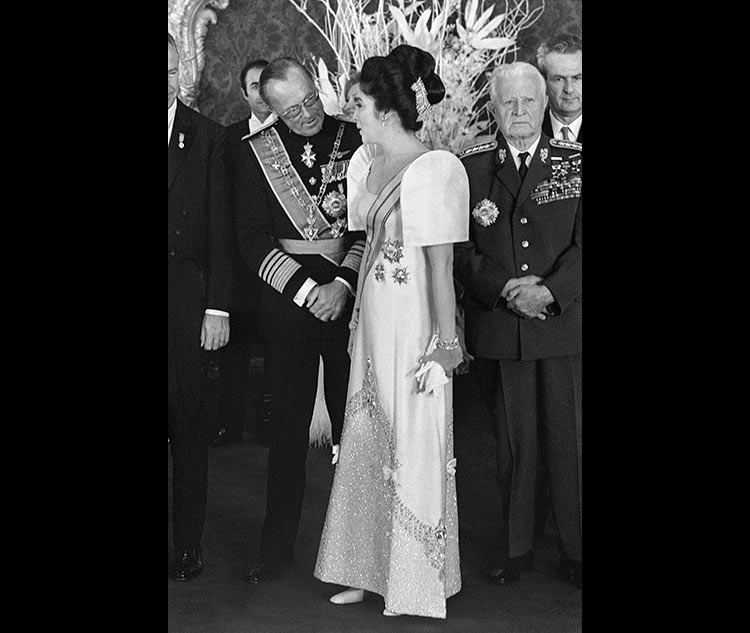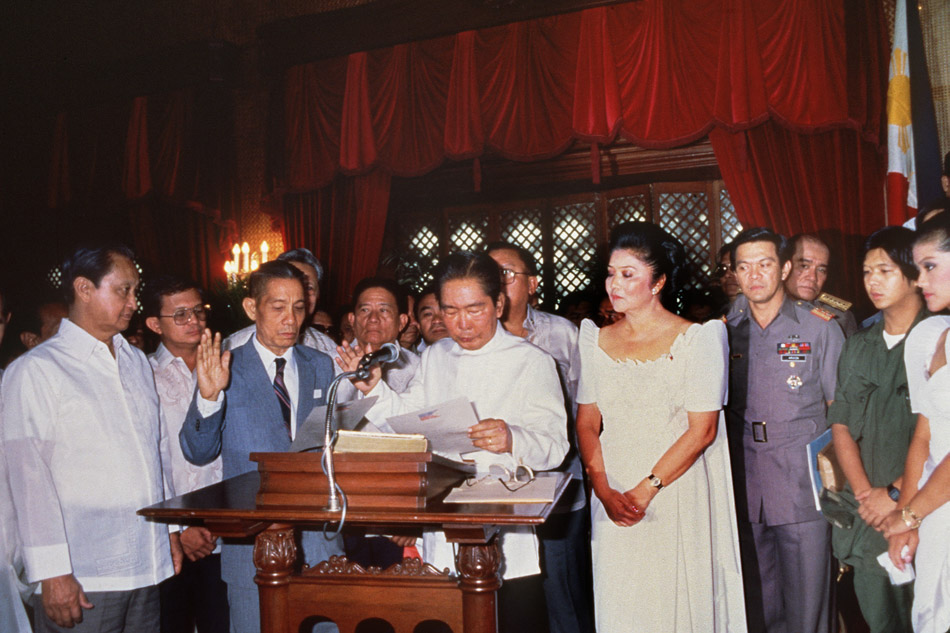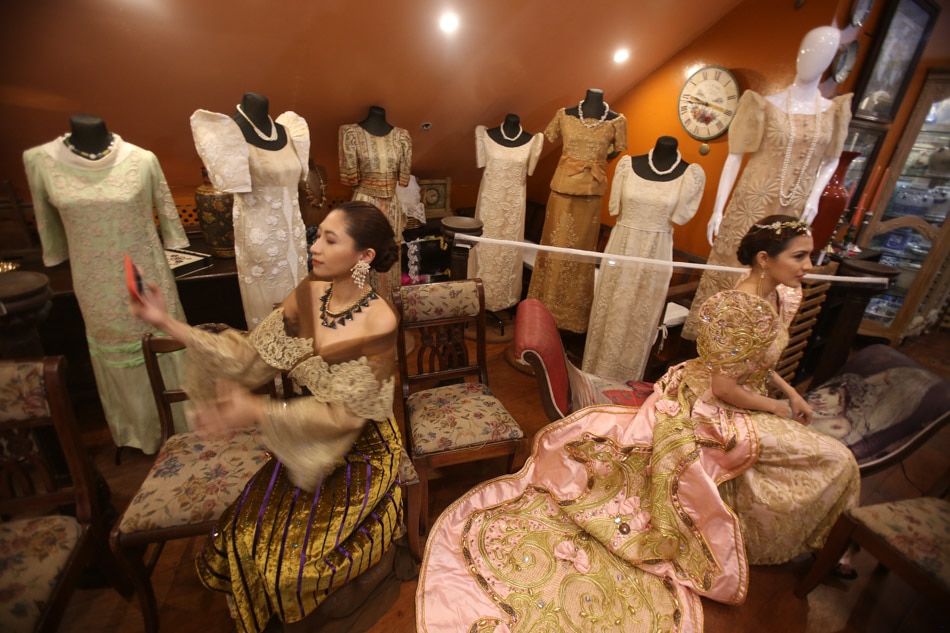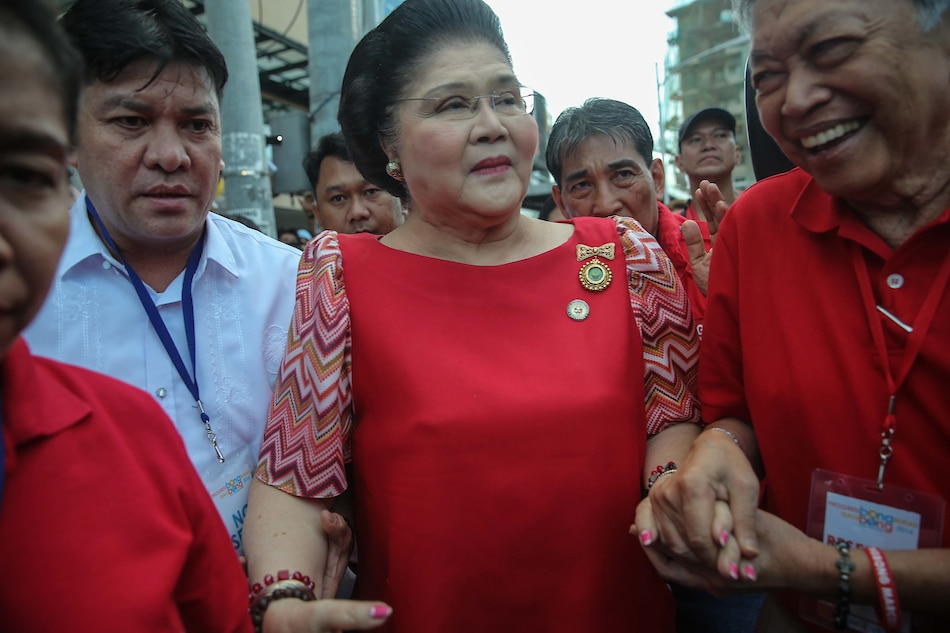Can the terno be dissociated from its Imeldific iconography? | ABS-CBN
ADVERTISEMENT

Welcome, Kapamilya! We use cookies to improve your browsing experience. Continuing to use this site means you agree to our use of cookies. Tell me more!
Can the terno be dissociated from its Imeldific iconography?
Can the terno be dissociated from its Imeldific iconography?
Wena Cos,
ABS-CBN News
Published Jun 08, 2022 07:31 PM PHT
MANILA - The "terno" or the Filipina dress characterized by the iconic butterfly sleeves made a symbolic return to the country's top offices when Ferdinand "Bongbong" Marcos Jr. was proclaimed the duly elected 17th president of the Philippines on May 26.
MANILA - The "terno" or the Filipina dress characterized by the iconic butterfly sleeves made a symbolic return to the country's top offices when Ferdinand "Bongbong" Marcos Jr. was proclaimed the duly elected 17th president of the Philippines on May 26.
The former first lady Imelda Romualdez-Marcos and her daughter-in-law Bongbong Marcos Jr.'s wife, lawyer Louise "Liza" Araneta-Marcos, arrived at the Batasang Pambansa in ternos -- Imelda in a blush peach number, Liza in a textured aegean blue piece.
The former first lady Imelda Romualdez-Marcos and her daughter-in-law Bongbong Marcos Jr.'s wife, lawyer Louise "Liza" Araneta-Marcos, arrived at the Batasang Pambansa in ternos -- Imelda in a blush peach number, Liza in a textured aegean blue piece.
While Liza's knee-length terno had simple white diamond-shaped embellishments on her butterfly sleeves, Imelda's terno had an intricate orange embroidery which spread from her chest down to the hem, gently reminiscent of the more opulent ternos she used to wear.
While Liza's knee-length terno had simple white diamond-shaped embellishments on her butterfly sleeves, Imelda's terno had an intricate orange embroidery which spread from her chest down to the hem, gently reminiscent of the more opulent ternos she used to wear.
The terno is most closely associated with the former First Lady when she continued the tradition of wearing it as a "highly visible personality within the country and the international scene," said Gino Gonzales and Mark Lewis Higgins in the book "Fashionable Filipinas: An Evolution of the Philippine National Dress in Photographs, 1860-1960."
The terno is most closely associated with the former First Lady when she continued the tradition of wearing it as a "highly visible personality within the country and the international scene," said Gino Gonzales and Mark Lewis Higgins in the book "Fashionable Filipinas: An Evolution of the Philippine National Dress in Photographs, 1860-1960."
ADVERTISEMENT
Imelda made the terno her go-to outfit for formal events, official appearances, state visits, and when holding gatherings for her high-society friends and acquaintances during her husband Ferdinand E. Marcos Sr.'s presidency and succeeding dictatorship. She gave the terno an international stage in their 20 years of rule.
Imelda made the terno her go-to outfit for formal events, official appearances, state visits, and when holding gatherings for her high-society friends and acquaintances during her husband Ferdinand E. Marcos Sr.'s presidency and succeeding dictatorship. She gave the terno an international stage in their 20 years of rule.
But Imelda was not the first first lady to wear Filipiniana attire in the country's top office. Former President Manuel L. Quezon's family started the tradition of wearing national attires in the mid-1930s.
But Imelda was not the first first lady to wear Filipiniana attire in the country's top office. Former President Manuel L. Quezon's family started the tradition of wearing national attires in the mid-1930s.
"First Lady Aurora Quezon wore the terno to all functions and succeeding First Ladies followed her lead," Gonzales and Higgins said, although Aurora Quezon's terno was the more traditional attire from which Imelda's butterfly sleeve dress was derived.
"First Lady Aurora Quezon wore the terno to all functions and succeeding First Ladies followed her lead," Gonzales and Higgins said, although Aurora Quezon's terno was the more traditional attire from which Imelda's butterfly sleeve dress was derived.
The terno, as we know it today, hails from the traditional "Maria Clara" or the traje de mestiza, a four-piece outfit worn by Filipino women during the Spanish colonization era: a camisa, or a blouse with sleeves shaped like bells or angel wings called "pagoda" in the 1800s; a pañuelo, or a piece of cloth usually the same as the camisa material folded into a triangle and worn around the shoulders; the modest saya, or skirt; and sometimes a tapis, a knee-length cloth that wraps the hips and hangs to the knees.
The terno, as we know it today, hails from the traditional "Maria Clara" or the traje de mestiza, a four-piece outfit worn by Filipino women during the Spanish colonization era: a camisa, or a blouse with sleeves shaped like bells or angel wings called "pagoda" in the 1800s; a pañuelo, or a piece of cloth usually the same as the camisa material folded into a triangle and worn around the shoulders; the modest saya, or skirt; and sometimes a tapis, a knee-length cloth that wraps the hips and hangs to the knees.
Higgins said this is what the term "terno" first meant: a matching set of camisa, pañuelo, and saya.
Higgins said this is what the term "terno" first meant: a matching set of camisa, pañuelo, and saya.
ADVERTISEMENT
The modern terno is often credited to National Artist for Fashion and Design Ramon Valera, who according to the National Commission for Culture and the Arts website gave "the country its visual icon to the world via the terno."
The modern terno is often credited to National Artist for Fashion and Design Ramon Valera, who according to the National Commission for Culture and the Arts website gave "the country its visual icon to the world via the terno."
"Valera produced a single piece of clothing from a four-piece ensemble consisting of a blouse, skirt, overskirt, and long scarf. He unified the components of the baro’t saya into a single dress with exaggerated bell sleeves, cinched at the waist, grazing the ankle, and zipped up at the back.
"Valera produced a single piece of clothing from a four-piece ensemble consisting of a blouse, skirt, overskirt, and long scarf. He unified the components of the baro’t saya into a single dress with exaggerated bell sleeves, cinched at the waist, grazing the ankle, and zipped up at the back.
"Valera constructed the terno’s butterfly sleeves, giving them a solid, built-in but hidden support. To the world, the butterfly sleeves became the terno’s defining feature."
"Valera constructed the terno’s butterfly sleeves, giving them a solid, built-in but hidden support. To the world, the butterfly sleeves became the terno’s defining feature."
Valera was even credited with the "shocking" removal of the modest pañuelo which provided additional covering over the female shoulder and chest area over the usually thin camisa.
Valera was even credited with the "shocking" removal of the modest pañuelo which provided additional covering over the female shoulder and chest area over the usually thin camisa.
But in an interview in 2016 with Gonzalez and Higgins said otherwise: "No one person invented it. It was a collective effort. The removal of the pañuelo, which is usually attributed to Valera, happened way, way before [he removed it]. Women have been trying to remove it way before.”
But in an interview in 2016 with Gonzalez and Higgins said otherwise: "No one person invented it. It was a collective effort. The removal of the pañuelo, which is usually attributed to Valera, happened way, way before [he removed it]. Women have been trying to remove it way before.”
ADVERTISEMENT
Over time, the terno has evolved as the dress itself changed. By the mid-1900s, the terno's pagoda sleeves were replaced with the now more-known butterfly sleeves, the camisa and saya evolved into a single dress, and the pañuelo made smaller or sometimes did away with altogether.
Over time, the terno has evolved as the dress itself changed. By the mid-1900s, the terno's pagoda sleeves were replaced with the now more-known butterfly sleeves, the camisa and saya evolved into a single dress, and the pañuelo made smaller or sometimes did away with altogether.
Higgins and Gonzales call this an "evolution through many phases of subtractions."
Higgins and Gonzales call this an "evolution through many phases of subtractions."
"By the 1950s, the word ‘terno’ had come to mean any style of dress with the butterfly sleeves attached to it. This has become the ‘glass ceiling’ of the terno – its sleeve," Higgins and Gonzales said in a written interview with ABS-CBN News.
"By the 1950s, the word ‘terno’ had come to mean any style of dress with the butterfly sleeves attached to it. This has become the ‘glass ceiling’ of the terno – its sleeve," Higgins and Gonzales said in a written interview with ABS-CBN News.
When Imelda made the terno her signature look in the 20 years of her husband's rule, the sharp silhouette of its iconic butterfly sleeves became synonymous to Marcos's bloody dictatorship, the lavish designs and embroidery of Imelda's preference a reminder of the family's extravagant lifestyles which were eventually brought to light after the his ouster in 1986.
When Imelda made the terno her signature look in the 20 years of her husband's rule, the sharp silhouette of its iconic butterfly sleeves became synonymous to Marcos's bloody dictatorship, the lavish designs and embroidery of Imelda's preference a reminder of the family's extravagant lifestyles which were eventually brought to light after the his ouster in 1986.
The terno then saw a decline in use in public to avoid this association; former female president Corazon Aquino wore a simple yellow vestido or dress during her inauguration.
The terno then saw a decline in use in public to avoid this association; former female president Corazon Aquino wore a simple yellow vestido or dress during her inauguration.
ADVERTISEMENT
"You have decades that passed since the Marcos periods have ended, and you have designers who didn’t know how to make the sleeves properly anymore," Higgins said in another interview in 2017.
"You have decades that passed since the Marcos periods have ended, and you have designers who didn’t know how to make the sleeves properly anymore," Higgins said in another interview in 2017.
But to credit the country's loss of touch from the terno to "one single reason (or person) is an oversimplistic, albeit common opinion," Higgins and Gonzales said.
But to credit the country's loss of touch from the terno to "one single reason (or person) is an oversimplistic, albeit common opinion," Higgins and Gonzales said.
Their research for "Fashionable Filipinas" found that the terno began to fade from popular use as far back as the 1920s.
Their research for "Fashionable Filipinas" found that the terno began to fade from popular use as far back as the 1920s.
"Young Filipina women wanted to be modern, and the influence of American-style dressing became that symbol of modernity," Gonzales and Higgins noted.
"Young Filipina women wanted to be modern, and the influence of American-style dressing became that symbol of modernity," Gonzales and Higgins noted.
It did not help the terno when global fashion trends started to sprout from the street styles of London instead of couture houses of Paris, which sported more relaxed and less formal looks of the "Youthquake."
It did not help the terno when global fashion trends started to sprout from the street styles of London instead of couture houses of Paris, which sported more relaxed and less formal looks of the "Youthquake."
ADVERTISEMENT
"By the middle of the 1960s, ternos had already vanished from everyday life," Gonzales and Higgins said. "One would see a few of them in church worn by elderly women, or sometimes out in the rural areas. Other than that, ternos occasionally appeared among the cultural community or people in government, and that was it."
"By the middle of the 1960s, ternos had already vanished from everyday life," Gonzales and Higgins said. "One would see a few of them in church worn by elderly women, or sometimes out in the rural areas. Other than that, ternos occasionally appeared among the cultural community or people in government, and that was it."
"For a young Filipina girl in the 1960s, the terno would have been far too impractical and costume-like for her wardrobe, and the last thing she wanted was to wear something her mother or grandmother was wearing."
"For a young Filipina girl in the 1960s, the terno would have been far too impractical and costume-like for her wardrobe, and the last thing she wanted was to wear something her mother or grandmother was wearing."
But the terno persisted and it continued to be worn through the years. When World War II ended, Gonzales and Higgins' research credit "a surge of nationalism" after the war which brought some of the most avant-garde incarnations of the terno in the '40s to the late '50s.
But the terno persisted and it continued to be worn through the years. When World War II ended, Gonzales and Higgins' research credit "a surge of nationalism" after the war which brought some of the most avant-garde incarnations of the terno in the '40s to the late '50s.
Apart from the gap during Cory Aquino's term where she avoided the terno and sometimes opted for a camisa or baro and even a barong, ternos could be see again during the inaugurations of succeeding presidents.
Apart from the gap during Cory Aquino's term where she avoided the terno and sometimes opted for a camisa or baro and even a barong, ternos could be see again during the inaugurations of succeeding presidents.
Fidel V. Ramos's wife wore a terno during his inauguration, while former president Gloria Macapagal-Arroyo wore ternos during both of hers.
Fidel V. Ramos's wife wore a terno during his inauguration, while former president Gloria Macapagal-Arroyo wore ternos during both of hers.
ADVERTISEMENT
And while former presidents Benigno Aquino III and outgoing president Rodrigo Duterte did not officially have first ladies, the terno was well-represented by their family members. Aquino's sister Kris wore a yellow one during his inauguration, while Duterte's daughter Sara wore a blue number during his.
And while former presidents Benigno Aquino III and outgoing president Rodrigo Duterte did not officially have first ladies, the terno was well-represented by their family members. Aquino's sister Kris wore a yellow one during his inauguration, while Duterte's daughter Sara wore a blue number during his.
Prior to her son's proclamation in May, Imelda herself has sported tamer versions of the terno, the sleeves more puff than butterfly.
Prior to her son's proclamation in May, Imelda herself has sported tamer versions of the terno, the sleeves more puff than butterfly.
"The terno has already moved past any negative connotations from the past, and is widely regarded today as a national garment that progressed beyond political affiliations or any socio-political barriers," Higgins and Gonzales said.
"The terno has already moved past any negative connotations from the past, and is widely regarded today as a national garment that progressed beyond political affiliations or any socio-political barriers," Higgins and Gonzales said.
ADVERTISEMENT
ADVERTISEMENT



